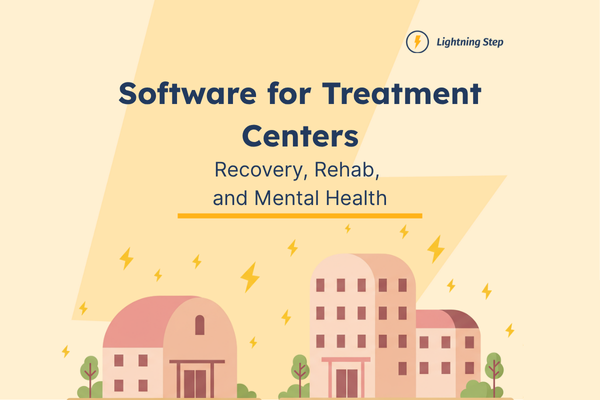
As the global behavioral health software market surges toward USD 30.62 billion by 2034 at a 16.98% CAGR, treatment centers face mounting pressure to deliver integrated care while managing complex compliance requirements and fragmented data systems. Generic electronic health record systems fall short of addressing the specialized needs of addiction recovery, mental health, and rehabilitation facilities. Purpose-built treatment center software offers a comprehensive solution designed specifically for these unique operational challenges.
North America's behavioral health software market was valued at USD 2.68 billion in 2024 with a 17.0% CAGR, highlighting regional growth. Grand View Research estimates the global behavioral health care software and services market at USD 4,142.5 million in 2024, projected to reach USD 8,605.8 million by 2030 at a 13.0% CAGR.
Treatment center software differs significantly from standard EHR systems. While generic platforms focus on basic medical records, specialized software addresses the complex workflows unique to behavioral health settings.
Addiction recovery and mental health centers struggle with fragmented patient data across multiple systems. Staff often enter the same information repeatedly, creating inefficiencies and increasing error rates. Manual workflows slow down admissions and discharge processes. Compliance gaps emerge when systems can't handle the specific requirements of behavioral health regulations.
Lightning Step exemplifies purpose-built software for these settings. The platform combines customer relationship management, electronic medical records, and revenue cycle management into one unified system, eliminating the data silos that plague many treatment centers.
Patient intake in behavioral health involves complex assessments covering mental health history, substance use patterns, and psychosocial factors. Treatment plans must accommodate both individual and group therapy sessions, with flexible scheduling that adapts to varying program lengths.
Confidentiality requirements under 42 CFR Part 2 demand stricter protections than standard HIPAA compliance. The February 2024 updates aligned Part 2 with HIPAA requirements while maintaining enhanced privacy protections for substance use disorder records.
Outcome tracking takes center stage in behavioral health. Programs must monitor relapse prevention metrics, treatment completion rates, and long-term recovery indicators to demonstrate effectiveness and secure continued funding.
HIPAA and 42 CFR Part 2 requirements shape every aspect of behavioral health software design. Systems must provide granular consent management, allowing patients to control exactly who accesses their information and for what purposes.
The key 42 CFR Part 2 final rule changes include:
Built-in audit trails track every data access and modification. Automated compliance checks flag potential violations before they occur. Lightning Step's compliance modules handle these requirements seamlessly, reducing administrative burden while maintaining strict security standards.
Customizable templates streamline assessments, treatment plans, and progress notes. Clinicians need forms that match their specific treatment modalities and documentation requirements.
LightningStep's drag-and-drop AI templates auto-populate clinical fields and summarize notes, saving over 12.5 hours monthly for each clinician. LightningStep's AI assistant LIA saves clinicians over 12.5 hours monthly on documentation, cutting burnout and speeding care.
Calendar management must handle complex scenarios: group sessions with capacity limits, individual appointments with specific therapist requirements, and family sessions that coordinate multiple schedules.
Waitlist management becomes critical when demand exceeds capacity. Automated reminders reduce no-shows and help maintain treatment continuity.
Integrated telehealth platforms eliminate the need for separate video conferencing tools. Secure messaging keeps communication within the treatment team while maintaining compliance requirements.
Behavioral health billing involves multiple payers with varying requirements. Per-diem rates, sliding fee scales, and bundled services create complexity that generic billing systems can't handle.
Revenue cycle management tools automate claims scrubbing, reducing denials and accelerating payments. Insurance verification happens in real-time, preventing coverage surprises during treatment.
KPI dashboards provide real-time visibility into client progress, staff productivity, and financial health. Treatment centers need metrics that demonstrate both clinical effectiveness and operational efficiency.
Custom reports support grant applications, regulatory submissions, and quality improvement initiatives. Analytics identify trends that inform treatment protocols and resource allocation decisions.
Treatment programs vary significantly in size, specialty focus, and operational approach. Software must adapt to these differences rather than forcing centers to change their proven methods.
Integration with laboratories, pharmacies, and state reporting systems eliminates manual data transfer. HL7 integration automates lab result and prescription sharing, reduces errors, and speeds claims processing.
API connectivity allows custom integrations with specialized tools that treatment centers may already use for specific functions. Leverage HL7 FHIR APIs for seamless lab and pharmacy data exchange.
Patient portals provide secure access to treatment progress and educational resources. Family members can receive updates while respecting patient privacy preferences.
Digital consent management streamlines admissions while ensuring proper documentation. Mobile access keeps families connected throughout the treatment process.
Implementation timelines matter when treatment centers need to maintain operations during system transitions. Professional services teams guide custom implementations and data migrations.
24/7 support ensures that technical issues don't disrupt patient care. User communities share best practices and implementation strategies across similar organizations.
Needs assessments should consider current caseload, services offered, and growth projections. The global addiction treatment market is projected to reach $60 billion by 2028.
Total cost of ownership includes licensing, implementation, training, and ongoing support. Hidden costs often emerge in data migration and workflow customization.
Data migration requires careful planning and validation. Implement data quality checks and validation rules throughout migration to ensure integrity, as recommended by Integrate.io. Staff training should begin before go-live to ensure smooth transitions. Phased rollouts reduce risk while allowing for adjustments based on early feedback.
Clear success metrics help measure implementation effectiveness and identify areas for optimization.
Ongoing updates maintain compliance with changing regulations. User feedback loops drive product improvements that benefit the entire user community.
Success metrics include reduced administrative time, improved patient outcomes, and positive financial impact. AI-powered documentation tools can save clinicians over 12.5 hours monthly on paperwork.
Ready to streamline compliance, boost patient outcomes, and drive ROI? Schedule a LightningStep demo today.



